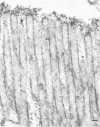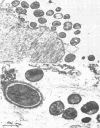Abstract
Morphological and microbiological techniques were used to locate and identify the microorganisms that colonized the human ileal conduits in 17 different patients from 5 days after surgery up to as many as 16 years of service as a urine conduit. The ecological sequence of this colonization assumes some practical importance because the ascending growth of pathogenic organisms in this essentially open, unvalved urinary tract diversion system leads to the development of life-threatening pyelonephritis. Extensive examination of the microvillus surfaces of the ilea of five accident victims by both transmission and scanning electron microscopy showed that these tissue surfaces were not colonized by bacteria, even in the absence of prophylactic antibiotic therapy, and that these surfaces were not occupied by adherent microorganisms after several years of service as a urine conduit, even when the skin surface stoma and the conduit contents were heavily colonized by bacteria and yeasts. During the initial period (10 days) of postoperative antibiotic therapy, the mucus and urine within the conduit were largely colonized by yeasts. A mixed population of yeasts and gram-positive cocci subsequently developed in the conduit itself, and gram-positive cocci were seen to be avidly adherent to epidermal cells at the stoma. As antibiotic protection was gradually withdrawn, gram-negative organisms became a part of the mixed microbial flora of the conduit contents, and some of the potentially pathogenic organisms of this group (e.g., Escherichia spp., Proteus spp., Pseudomonas spp., etc.) were isolated from patients with pyelonephritis that appeared to come from the ileal conduit.(ABSTRACT TRUNCATED AT 250 WORDS)
Full text
PDF






Images in this article
Selected References
These references are in PubMed. This may not be the complete list of references from this article.
- BRICKER E. M. Substitution for the urinary bladder by the use of isolated ileal segments. Surg Clin North Am. 1956 Aug;:1117–1130. doi: 10.1016/s0039-6109(16)34949-0. [DOI] [PubMed] [Google Scholar]
- Bergman B. Studies on patients with ileal conduit diversion with special regard to renal infection. Scand J Urol Nephrol Suppl. 1978;(47):1–32. [PubMed] [Google Scholar]
- Bishop R. F., Smith E. D., Gracey M. Bacterial flora of urine from ileal conduit. J Urol. 1971 Mar;105(3):452–455. doi: 10.1016/s0022-5347(17)61547-7. [DOI] [PubMed] [Google Scholar]
- Bruce A. W., Chan R. C., Pinkerton D., Morales A., Chadwick P. Adherence of gram-negative uropathogens to human uroepithelial cells. J Urol. 1983 Aug;130(2):293–298. doi: 10.1016/s0022-5347(17)51115-5. [DOI] [PubMed] [Google Scholar]
- COX C. E., HINMAN F., Jr Experiments with induced bacteriuria, vesical emptying and bacterial growth on the mechanism of bladder defense to infection. J Urol. 1961 Dec;86:739–748. doi: 10.1016/S0022-5347(17)65257-1. [DOI] [PubMed] [Google Scholar]
- Chan R. C., Bruce A. W., Reid G. Adherence of cervical, vaginal and distal urethral normal microbial flora to human uroepithelial cells and the inhibition of adherence of gram-negative uropathogens by competitive exclusion. J Urol. 1984 Mar;131(3):596–601. doi: 10.1016/s0022-5347(17)50512-1. [DOI] [PubMed] [Google Scholar]
- Chan R. C., Bruce A. W. The influence of growth media on the morphology and in vitro adherence characteristics of gram-negative urinary pathogens. J Urol. 1983 Feb;129(2):411–417. doi: 10.1016/s0022-5347(17)52128-x. [DOI] [PubMed] [Google Scholar]
- Cheng K. J., Irvin R. T., Costerton J. W. Autochthonous and pathogenic colonization of animal tissues by bacteria. Can J Microbiol. 1981 May;27(5):461–490. doi: 10.1139/m81-071. [DOI] [PubMed] [Google Scholar]
- Hendren W. H., McLorie G. A. Late stricture of intestinal ureter. J Urol. 1983 Mar;129(3):584–590. doi: 10.1016/s0022-5347(17)52248-x. [DOI] [PubMed] [Google Scholar]
- Marrie T. J., Lam J., Costerton J. W. Bacterial adhesion to uroepithelial cells: a morphologic study. J Infect Dis. 1980 Aug;142(2):239–246. doi: 10.1093/infdis/142.2.239. [DOI] [PubMed] [Google Scholar]
- Marrie T. J., Swantee C. A., Hartlen M. Aerobic and anaerobic urethral flora of healthy females in various physiological age groups and of females with urinary tract infections. J Clin Microbiol. 1980 Jun;11(6):654–659. doi: 10.1128/jcm.11.6.654-659.1980. [DOI] [PMC free article] [PubMed] [Google Scholar]
- Mebust W. K., Foret J. D., Valk W. L. Fifteen years of experience with urinary diversion in myelomeningocele patients. J Urol. 1969 Feb;101(2):177–182. doi: 10.1016/s0022-5347(17)62304-8. [DOI] [PubMed] [Google Scholar]
- Middleton A. W., Jr, Hendren W. H. Ileal conduits in children at the Massachusetts General Hospital from 1955 to 1970. J Urol. 1976 May;115(5):591–595. doi: 10.1016/s0022-5347(17)59294-0. [DOI] [PubMed] [Google Scholar]
- Needham R. N., Smith M. M., Matsen J. M. Differences in the bacteriology of intestinal loop urinary diversions. J Urol. 1970 Dec;104(6):831–833. doi: 10.1016/s0022-5347(17)61846-9. [DOI] [PubMed] [Google Scholar]
- Orskov I., Ferencz A., Orskov F. Tamm-Horsfall protein or uromucoid is the normal urinary slime that traps type 1 fimbriated Escherichia coli. Lancet. 1980 Apr 19;1(8173):887–887. doi: 10.1016/s0140-6736(80)91396-3. [DOI] [PubMed] [Google Scholar]
- Orskov I., Orskov F., Birch-Andersen A. Comparison of Escherichia coli fimbrial antigen F7 with type 1 fimbriae. Infect Immun. 1980 Feb;27(2):657–666. doi: 10.1128/iai.27.2.657-666.1980. [DOI] [PMC free article] [PubMed] [Google Scholar]
- Reid G., Brooks H. J., Bacon D. F. In vitro attachment of Escherichia coli to human uroepithelial cells: variation in receptivity during the menstrual cycle and pregnancy. J Infect Dis. 1983 Sep;148(3):412–421. doi: 10.1093/infdis/148.3.412. [DOI] [PubMed] [Google Scholar]
- Richie J. P., Skinner D. G., Waisman J. The effect of reflux on the development of pyelonephritis in urinary diversion: an experimental study. J Surg Res. 1974 Mar;16(3):256–261. doi: 10.1016/0022-4804(74)90040-7. [DOI] [PubMed] [Google Scholar]
- Rozee K. R., Cooper D., Lam K., Costerton J. W. Microbial flora of the mouse ileum mucous layer and epithelial surface. Appl Environ Microbiol. 1982 Jun;43(6):1451–1463. doi: 10.1128/aem.43.6.1451-1463.1982. [DOI] [PMC free article] [PubMed] [Google Scholar]
- Shapiro S. R., Lebowitz R., Colodny A. H. Fate of 90 children with ileal conduit urinary diversion a decade later: analysis of complications, pyelography, renal function and bacteriology. J Urol. 1975 Aug;114(2):289–295. doi: 10.1016/s0022-5347(17)67010-1. [DOI] [PubMed] [Google Scholar]
- Spence B., Stewart W., Cass A. S. Use of a double lumen catheter to determine bacteriuria in intestinal loop diversions in children. J Urol. 1972 Nov;108(5):800–801. doi: 10.1016/s0022-5347(17)60873-5. [DOI] [PubMed] [Google Scholar]








